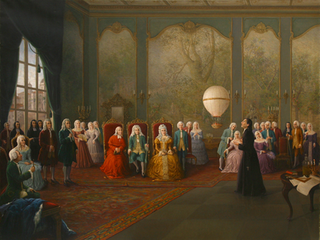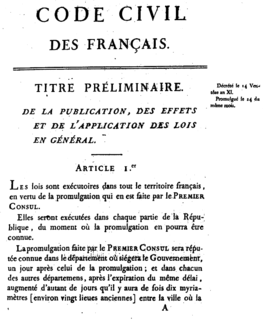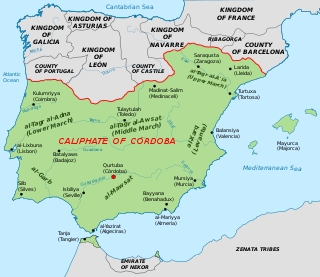
An emperor is a monarch, and usually the sovereign ruler of an empire or another type of imperial realm. Empress, the female equivalent, may indicate an emperor's wife, mother, or a woman who rules in her own right. Emperors are generally recognized to be of the highest monarchic honour and rank, surpassing kings. In Europe, the title of Emperor has been used since the Middle Ages, considered in those times equal or almost equal in dignity to that of Pope due to the latter's position as visible head of the Church and spiritual leader of the Catholic part of Western Europe. The Emperor of Japan is the only currently reigning monarch whose title is translated into English as "Emperor", while holding no actual political power.
Year 1000 (M) was a leap year starting on Monday of the Julian calendar. In the proleptic Gregorian calendar, it was a non-leap century year starting on Wednesday. It was also the last year of the 10th century as well as the last year of the 1st millennium of the Dionysian era ending on December 31, but the first year of the 1000s decade.

The second millennium of the Anno Domini or Common Era was a millennium spanning the years 1001 to 2000.

The term Moor is an exonym first used by Christian Europeans to designate the Muslim inhabitants of the Maghreb, the Iberian Peninsula, Sicily, and Malta during the Middle Ages. The Moors initially were the indigenous Maghrebine Berbers. The name was later also applied to Arabs and Arabized Iberians.

The Abbasid Caliphate was the third caliphate to succeed the Islamic prophet Muhammad. It was founded by a dynasty descended from Muhammad's uncle, Abbas ibn Abdul-Muttalib, from whom the dynasty takes its name. They ruled as caliphs for most of the caliphate from their capital in Baghdad in modern-day Iraq, after having overthrown the Umayyad Caliphate in the Abbasid Revolution of 750 CE (132 AH). The Abbasid Caliphate first centered its government in Kufa, modern-day Iraq, but in 762 the caliph Al-Mansur founded the city of Baghdad, near the ancient Sasanian capital city of Ctesiphon. The Abbasid period was marked by reliance on Persian bureaucrats for governing the territories as well as an increasing inclusion of non-Arab Muslims in the ummah. Persian customs were broadly adopted by the ruling elite, and they began patronage of artists and scholars. Baghdad became a center of science, culture, philosophy and invention in what became known as the Golden Age of Islam.

The Latins were originally an Italic tribe in ancient central Italy from Latium. As Roman power and colonization spread Latin culture, during the Roman Empire, Latins came to mean mostly unified Italic Latin-speaking people and the Latin-speaking people of Dacia, Iberia, Illyria, and Gaul whose land was settled by Roman colonists. Today, Latin people are those whose languages are derived from Latin; Italians, French, Spanish, Portuguese, Romanians, etc.

A tribute (/ˈtrɪbjuːt/) is wealth, often in kind, that a party gives to another as a sign of respect or, as was often the case in historical contexts, of submission or allegiance. Various ancient states exacted tribute from the rulers of land which the state conquered or otherwise threatened to conquer. In case of alliances, lesser parties may pay tribute to more powerful parties as a sign of allegiance and often in order to finance projects that would benefit both parties. To be called "tribute" a recognition by the payer of political submission to the payee is normally required; the large sums, essentially protection money, paid by the later Roman and Byzantine Empires to barbarian peoples to prevent them attacking imperial territory, would not usually be termed "tribute" as the Empire accepted no inferior political position. Payments by a superior political entity to an inferior one, made for various purposes, are described by terms including "subsidy".

A royal court is an extended royal household in a monarchy, including all those who regularly attend on a monarch, or another central figure. Hence the word court may also be applied to the coterie of a senior member of the nobility. Royal courts may have their seat in a designated place, several specific places, or be a mobile, itinerant court.

The Maghreb ; Arabic: المغرب al-Maghrib, "the west"), also known as Northwest Africa, the Greater Maghreb, and historically "TheBarbary coast", is the western part of North Africa. The region includes Algeria, Libya, Mauritania, Morocco, and Tunisia. The Maghreb additionally includes the disputed territories of Western Sahara and the cities of Ceuta and Melilla. As of 2018, the region had a population of over 100 million people.

The flag of Lebanon is formed of two horizontal red stripes enveloping a horizontal white stripe. The white stripe is twice the height of the red ones —a Spanish fess. The green cedar in the middle touches each of the red stripes and its width is one third of the width of the flag.

This timeline tries to compile dates of important historical events that happened in or that led to the rise of the Middle East. The Middle East is the territory that comprises today's Egypt, the Persian Gulf states, Iran, Iraq, Palestine, Cyprus and Northern Cyprus, Israel, Jordan, Lebanon, Oman, Saudi Arabia, Syria, Turkey, Gaza Strip, UAE, & Yemen. The Middle East with its particular characteristics was not to emerge until the late second millennium AD. To refer to a concept similar to that of today's Middle East but earlier in time, the term Ancient Near East is used.

A code of law, also called a law code or legal code, is a type of legislation that purports to exhaustively cover a complete system of laws or a particular area of law as it existed at the time the code was enacted, by a process of codification. Though the process and motivations for codification are similar in different common law and civil law systems, their usage is different.
Silver coins are possibly the oldest mass-produced form of coinage. Silver has been used as a coinage metal since the times of the Greeks; their silver drachmas were popular trade coins. The ancient Persians used silver coins between 612-330 BC. Before 1797, British pennies were made of silver.

Ténès is a town in Algeria located around 200 kilometers west of the capital Algiers. As of 2000, it has a population of 35,000 people.

Roman Armenia refers to the rule of parts of Greater Armenia by the Roman Empire, from the 1st century AD to the end of Late Antiquity. While Armenia Minor had become a client state and incorporated into the Roman Empire proper during the 1st century AD, Greater Armenia remained an independent kingdom under the Arsacid dynasty. Throughout this period, Armenia remained a bone of contention between Rome and the Parthian Empire, as well as the Sasanian Empire that succeeded the latter, and the casus belli for several of the Roman–Persian Wars. Only in 114–118 was Emperor Trajan able to conquer and incorporate it as a short-lived province.

The following outline is provided as an overview of and topical guide to the continent Africa:

The Caliphate of Córdoba was an Islamic state, ruled by the Umayyad dynasty from 929 - 1031. Its territory comprised Iberia and parts of North Africa, with its capital in Córdoba. The region was formerly dominated by the Umayyad Emirate of Córdoba (756–929). The period was characterized by an expansion of trade and culture, and saw the construction of masterpieces of al-Andalus architecture. In January 929, Abd ar-Rahman III proclaimed himself Caliph of Córdoba, replacing thus his original title of Emir of Córdoba. He was a member of the Umayyad dynasty, which had held the title of Emir of Córdoba since 756.














